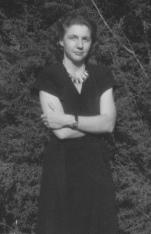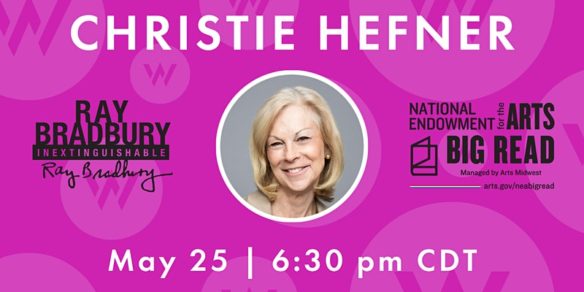(1) WHO RAY LEARNED FROM. The Ray Bradbury Experience Museum invites you to “Meet Ray Bradbury’s Greatest Writing Mentor: Leigh Douglass Brackett”.

…“Her stories were very simple, and well-plotted, and very beautiful. I learned from her how to pare my stories down and how to plot,” Bradbury said. —Sam Weller in The Bradbury Chronicles.
Brackett was a masterful storyteller of limitless imagination, exquisite writing skills and quite an impressive range. She was ahead of her time just as she was ahead of most of her colleagues, Sven Mikulec reports in Cinephilia Beyond. She was known as the “Queen of Space Opera.”…
(2) WALKING WAUKEGAN. Also, the “Ray Bradbury museum offers virtual tour of his life in Waukegan” – and the Chicago Tribune took it.
…As the pandemic continues, the museum is offering online experiences such as the virtual tour and the “I Met Ray” video project, also in the News & Media tab. The virtual tour, paid for with a grant from Chicago-based nonprofit Illinois Humanities, focus a great deal on the library, one of Bradbury’s favorite places, according to Sandra Petroshius, committee chair of the museum. “Bradbury just loved the library,” said Petroshius, who grew up in Waukegan and lives in Lake Forest. “He showed that in his writings,” she said.
Bradbury’s book, “Something Wicked This Way Comes,” is set in the library, and one of the characters works at a library, she said….
(3) PANDEMIC TIMES. Bradbury biographer Sam Weller looks back at “Ray Bradbury and the Last Global Pandemic” in the LA Review of Books.
…For all the years I spent with him (12 in total, five during which I saw him every two weeks, flying from Chicago to Los Angeles as I was writing his authorized biography), he would often speak about the 1918 virus, the so-called “Spanish flu.” This was in the early 2000s, when few understood the damage a pandemic could wreak. Pandemics were the stuff of a Michael Crichton novel, not our own reality.
Bradbury was dumbfounded that the 1918 tragedy had faded from our cultural consciousness. “Nobody talks about it anymore,” he said with remorse. The 1918 pandemic claimed at least 50 million lives around the world; in the United States, the death toll is estimated to be near 675,000.
…Bradbury lost two family members to the 1918 pandemic. These deaths, with their associated grief, imbue much of his oeuvre. Mortality, loneliness, letting go were the central motifs to Bradbury’s first book, Dark Carnival (1947), published when he was only 27 years old, and dubbed by Stephen King as the “Dubliners of American Gothic.”
Ray Bradbury was born on August 22, 1920, after the flu pandemic had ended. The virus had taken a devastating toll on his family. I have spent two decades delving into Bradbury’s genealogy, combing through lost records, staring blurry-eyed at microfiche screens, trying to understand and fully appreciate how Bradbury’s formative years (what he called his “root system”) shaped him as a writer….
(4) BEWARE PIRATES. Barry Hoffman, Publisher, Gauntlet Press sent out this warning to his list on April 28:
Have you ever come across a deal that seemed too good to pass up? A customer wrote to me asking if a 3000 copy edition of Ray Bradbury’s Dark Carnival being offered by Dragon Books was a scam. The offer seemed to be too good to be true … and in fact, it was an illegal sale of the title.
When Ray Bradbury agreed to let us publish his first short story collection as a signed limited his agent, Don Congdon, told me it would be the only printing of the book, after which it would go back into the vault. But here was a listing of the book for $3.99 with a bookplate signed by Bradbury (with the cover art of our version). It made no sense. Bradbury, of course, has passed away. He agreed with his agent that after our release of the book there should be no other. And, where would the publisher get 3000 bookplates SIGNED by Bradbury? To offer a SIGNED version of Bradbury’s acclaimed first book for less than $4 was ludicrous.
I contacted Bradbury’s agent Michael Congdon (son of Don) who sent Dragon Books a cease and desist letter. They agreed and the listing has been removed….
It has always been our goal to protect the legacy of authors we have published. Ray Bradbury and Richard Matheson can no longer protect their work. However, both still have agents who will take action when an illegal version of their writing is offered. If you see Bradbury or Matheson books (especially signed versions) being offered (other than on legitimate secondary markets like eBay and Abe.com) please contact me at [email protected] and I will look into the offering and, if necessary, contact their agent.
(5) THE SPACE BETWEEN THE WORDS. In “A Science Fiction Author’s Pointers for Worldbuilding with Negative Space” on CrimeReads, Stina Leicht cites classics by Bradbury, Le Guin, and Butler as examples of how it’s what you don’t show in worldbuilding that is as important as what you do show.
…It might be easier to imagine world-building as an iceberg floating in the sea of plot. The reader only sees a small percentage of it. The rest is deep beneath the water and affects everything in the water—visibly and invisibly. That said, communicating with the empty spaces takes a deft hand because the border between too little and just right is quite thin. In addition, Americans in particular are often socially conditioned to say more and listen less. That’s why world building in the blank spaces is an advanced technique most often employed by authors with experience and skill.
A great deal of worldbuilding can happen with what is left unsaid….
(6) A WIDE FANBASE. The “Ray Bradbury: Inextinguishable” virtual exhibit at the American Writers Museum includes a treasured letter. (Click for larger image.)
One of the letters that Ray received in 2003 was of particular significance. It was from Thomas Steinbeck, the son of Ray’s childhood literary hero John Steinbeck.
In the letter, Thomas told Ray that the entire family had been fans of him for years. John would read to the children, and would often choose Ray’s stories. This in turn inspired Thomas to become a writer when he got older. It is amazing that Ray inspired the son of a writer that inspired him so much, and shows the enduring legacy of his writing and personality.
The File 770 post “Bradbury at Big Read” includes a photo of Ray and Thomas at an encounter in Santa Barbara in 2009.
(7) CLIFTON’S CAFETERIA. The eatery hosted LASFS gatherings in the Thirties, and Ray held court there may times in later years. This is/was the dedicated Ray Bradbury booth at Clifton’s in the Gothic Bar room. Photo by Steve Leiva.

(8) LANSDALE ON BRADBURY. Joe R. Lansdale joined a RBEM Virtual Session to talk about Hap & Leonard, Batman and Ray Bradbury.
(9) THE ORIGINAL 451. Christie Hefner will discuss Playboy Magazine and Ray Bradbury’s Fahrenheit 451 in a free livestream on May 25, 6:30 Central. Register at Eventbrite: “Playboy and Fahrenheit 451: A Program with Christie Hefner”.

In 1954, when Playboy magazine was in its infancy, it published a three-part serialized novel about the perils of censorship and the seductive lure of anti-intellectual movements. The magazine introduced thousands of readers unfamiliar with science fiction to the genre’s masterwork and helped make it a classic. Former Chairman, CEO Playboy Enterprises Christie Hefner talks about the landmark publication and its influence.
This program is made possible by NEA Big Read. NEA Big Read is a program of the National Endowment for the Arts (NEA) designed to broaden our understanding of our world, our communities, and ourselves through the joy of sharing a good book. The American Writers Museum is one of 78 not-for-profit organizations to receive a grant to host an NEA Big Read project between September 2019 and December 2021. The NEA presents NEA Big Read in partnership with Arts Midwest.
(10) THE HEADLINER. Franco Laguna Correa discusses “Ray Bradbury on War, Recycling, and Artificial Intelligence” at Public Books.
One of the roles of science fiction is to provide readers with a glimpse of how the future could be.1 Ray Bradbury didn’t get everything about the future right. We haven’t yet seen books and reading made illegal (as in his 1953 Fahrenheit 451),2 just as we haven’t yet discovered another planet ready for American colonizers (as in his 1950 The Martian Chronicles). And yet, the themes he explored in those books—mass media and censorship, colonization and environmental change—are more relevant than ever. Even in his lesser-known works—such as the 1951 sci-fi collection The Illustrated Man, Bradbury tackles a surprising array of issues that feel as if they were ripped from today’s headlines….
(11) RAY TALKS ABOUT DISNEY. In “The Optimistic Futurist” Leonard Maltin interviews Ray Bradbury about Walt Disney.
From the Walt Disney Treasures DVDs, this is an interview about Walt Disney. It is a bonus feature from the set, and here it is meant to shed light on the genius of Walt Disney.
(12) HISTORIC INFLUENCE. Dana Gioia calls it the “Ray Bradbury’s Butterfly Effect”:
…Was Bradbury really a major writer? Or was he simply the amiable pioneer of a dynamic popular genre? The question persists, so let me offer what I believe will be Bradbury’s particular claim to literary posterity. For one astonishingly productive decade—from 1950 to 1960—Ray Bradbury was probably the most influential fiction writer in the English language. Please note that I’m not claiming he was the best writer or that he exerted the most influence on his fellow writers. In strictly literary terms, Bradbury was not remotely the equal of Flannery O’Connor, Graham Greene, Chinua Achebe, John Cheever, or a dozen other of his Anglophonic contemporaries. Bradbury’s enormous impact was felt mostly outside the literary world—on scientists, filmmakers, architects, engineers, journalists, librarians, artists, and entrepreneurs. Above all, his influence was felt on the young, the generation of adolescents who would shape the late twentieth and early twenty-first centuries. Bradbury’s impact is still evident from Disneyland to Cape Canaveral, from Hollywood to Silicon Valley. It is even evident on other planets. When the Mars rover Curiosity touched down two months after the author’s death, NASA scientists named the spot Bradbury Landing. He was the paperback bard of book burning, the Butterfly Effect, virtual reality, and the full-body tattoo. Bradbury’s dreams and nightmares of space travel, nuclear holocaust, interactive media, robotics, censorship, mass illiteracy, and environmental payback provided the mythic structure for millions of other dreamers in science, entertainment, and technology.
(13) RAY BRADBURY & COMICS. The staff from the Ray Bradbury Experience Museum share behind-the-scenes views of the museum and stories of Bradbury’s love of comics in this 90-minute video.
[Thanks to John King Tarpinian, Michael Toman, Will R., and Martin Morse Wooster for these stories.]

